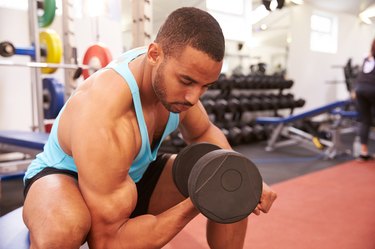
A dumbbell curl targets your biceps, the muscles on the front of your upper arms. There are many versions of a dumbbell curl, including alternating and standing, which are not mutually exclusive, since an alternating dumbbell curl can be done standing. The standing variation works your abdominal muscles slightly, but seated variations do not.
Dumbbell Curl
Video of the Day
Regardless of whether you are standing, seated, doing both arms simultaneously or alternating arms, a dumbbell curl is executed in basically the same manner. Hold a dumbbell in each hand with your palms facing forward. Your arms should be fully extended, hanging at your sides. Lock your upper arms next to your sides and do not move them. Exhale and curl the dumbbell up to your shoulder by bending your elbow. Inhale and lower the dumbbell back to the starting position.
Video of the Day
Standing vs. Seated
The dumbbell curl exercise can be done seated or standing. The execution of the movement is the same in either position; however, the American Council on Exercise says the abdominal muscles play a larger role in a standing dumbbell curl. When in a standing position, it recommends you brace your torso by engaging your abdominal muscles. This is not necessary in a seated position. Although you are not actively contracting your abdominal muscles during a standing dumbbell curl, they do isometrically contract -- shorten without changing length -- to help stabilize your body.
Alternating
The alternating dumbbell curl exercise can be done standing or seated. Holding a dumbbell in each hand, you complete a full repetition on one arm and then the other arm. Keep one arm stationary while you curl the other and alternate between sides. This allows you to fully concentrate on one arm at a time, taking full advantage of the mind-muscle connection; and each side has more time to rest between curls when alternating as opposed to working both arms in unison. As with any standing dumbbell curl, an alternating standing dumbbell curl will work the abdominal muscles more than a seated alternating dumbbell curl.
Considerations
Although the dumbbell curl is a basic, single-joint exercise, make sure to do the exercise with proper form. Do not allow your wrists to curl as you lift the weight. Keep your wrist aligned with your forearm throughout the movement. Do not rest the weight on your shoulders at the top of the movement. Lower the weight with control; do not let it drop back down. Exhale as you curl up and inhale as you lower the dumbbells.